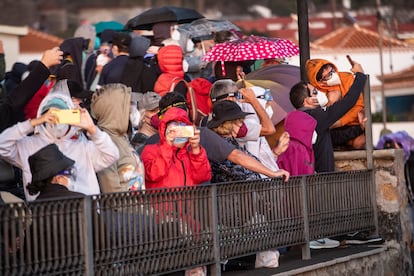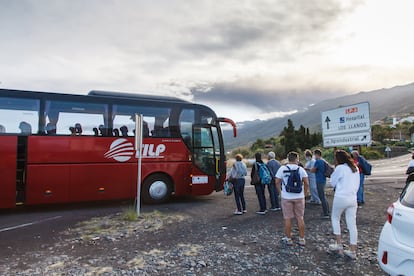Packed buses and traffic jams on the roads: Volcano tourism overwhelms La Palma
A shuttle service is running to the vantage point for observation of the volcanic eruption, and demand is such that passengers have to wait at least an hour to board. Locals are divided on the benefits of the visitors


Saturday was not the best day to observe the new volcano on La Palma. Ash was raining down like water, darkening the sky and worsening visibility. However, the vantage point at the Tajuya church in El Paso was still packed with people observing the eruption. This is the best point to see the volcano, and this long weekend – Monday is a national holiday due to All Saints Day – it was a must-see destination for tourists. The hotels on the Canary Island – a Spanish archipelago located off the northwest coast of Africa – are so overbooked that the island council has had to put on shuttle buses that run every half an hour from the old Buenavista airport, located near the capital of Santa Cruz and far from the cloud of ash, and take the tourists to the church.
“This is amazing,” says Ricardo Gutiérrez, a 38-year-old from Seville who is using an umbrella to protect himself from the falling ash. He’s at the very front of the vantage point. Behind him, two friends are trying to make room among the crowd so that they can see the mountain of fire. Their names are María Pérez and Adelaida Ramos, both aged 29 and from Valencia. “The truth is that you can’t see it as well as I expected and it’s a bit overwhelming with all these people, but I don’t know when I’ll be able to see a volcano again,” says Pérez.
After a while spent looking at the eruption, which began on September 19 and shows no sign of stopping anytime soon, they leave the vantage point to catch the bus back to Santa Cruz. But the line to board is very long. A little girl is killing time playing with the volcanic sand, while a teenager records a video of the ash falling through his hands.
“We’ve been here an hour,” says Juan Antonio Herrera, who is at the front of the line. “The buses take half an hour to get to the other side. We’ve been thinking about coming for a while, but we were a little bit reluctant because the people [who live on La Palma] were having a bad time. But when you see that the rest of the island is inviting people to come and see the volcano, we made our mind up. It’s a way of supporting them,” says the 47-year-old from Tenerife, another of the Canary Islands.
This debate has been troubling a lot of the visitors. On the one hand they want to enjoy this extraordinary natural phenomenon. But at the same time they understand that some of the people who have lost their homes may see it as frivolous. As Herrera said, the local authorities themselves have been encouraging people to come and visit.
“We are grateful that so many tourists are coming,” said Miguel Ángel Morcuende, the technical director of the team of experts monitoring the phenomenon, the Volcano Risk Prevention Plan (Pevolca), at a press conference on Saturday. “We have asked for support, and this is that, to solve some of the problems that we have on the island. This confirms what we have said every day, that the island is safe.”

He put the numbers of tourists on the island at 10,000 people. “I’ve been here before and I’ve neve seen the vantage point at the church so full,” says Lorena Pérez, a 38-year-old resident of Santa Cruz.
But Carmen Justiniana, 50 and from Bolivia, does not agree with Morcuende. She is a resident of Los Llanos de Aridane municipality on the island, and has seen the lava swallow up the land belonging to her brother and the homes of several friends. “They can call it a spectacle, but for us it is not,” she complains. “How much money are all of these people spending, and where? I’ve come from Los Llanos and the center is empty, you can’t see anyone. The people who have lost their homes are trying to rent places and it is more difficult due to all of the tourists who are coming.” She is referring to the spike in demand for housing, which has pushed prices up.
While most of the visitors arrive at the church on the bus, many more opt for taxis or private cars. The road that runs up there from Los Llanos is dotted with badly parked cars, despite signs prohibiting people from stopping. There are even traffic jams. Many visitors walk the route, whose white lines have been erased by the ash. The most prudent wear reflective jackets and have their cellphone torches on.
In a safe area of the road, far from the crowds, four friends are observing the volcano. Two of them are from Murcia. “To get here we had to go from Murcia to Alicante, from there to the airport in north Tenerife, two hours of bus to Los Cristianos [in the south of the island], and from there we caught the ferry to La Palma,” explains Paco Díaz, 54. They left at 8am and arrived at 10pm. “We are taking amazing photos,” says Encarna Vera, 54. “We went to other points of the island to see it, such as the Time vantage point. From there it looks like Mordor,” she jokes, in reference to the volcanic realm in Lord of the Rings. “It’s a journey of contrasts,” adds Díaz. “You see people who are very sad and desperate with this constant rumbling. When we were eating we couldn’t believe the noise from the volcano, and one local said to us that this was nothing.”

They ate at the port in Tazacorte, which is the most touristy spot near the volcano. “There weren’t many people,” José Luis del Saz, 55, explains. He has traveled from Madrid with Cristina Cezón, 54. “What would be happening on the island if there were no tourists?” he asks. “At the vantage point everyone is very quiet, I think that people are aware that this is a dramatic situation and we have to be respectful. I haven’t seen people laughing and joking,” Cezón adds.
A glance at hotel booking websites confirms that it’s practically impossible to find a place to stay on the island. The Villa María apartments, in El Paso, are among the closest lodgings to the vantage point in Tajuya, which is the focal point for tourists. But they are closed. “I’d love to open, but it’s impossible,” explains José González, who is in charge of the apartments. “The ash is raining down constantly, and centimeters and centimeters of it build up. You sweep up and it ends up the same straight away. There’s no way I can open up.” He says he is sure he would have the place full if he could open, but his staff is on the Spanish government’s ERTE furlough scheme.
The hotels that can open in the area closest to the volcano are indeed full, according to Alejandro Herrera, who works at the Valle de Aridane hotel. “Eighty-five percent of our rooms are for people who were evacuated due to the volcano,” he explains. “The other 15% are taken up by tourists who have come to see the eruption.”
Sergio Pérez, who coordinates tourist apartments in the area, says that the requests are coming non-stop and that he is having to turn them down. “You have to book well in advance,” he says.
A number of hotels in Santa Cruz, which is on the other side of the island, also confirm that they are full. It is the most touristy area of La Palma together with Puerto Naos, which is inside the volcano exclusion zone.
Tu suscripción se está usando en otro dispositivo
¿Quieres añadir otro usuario a tu suscripción?
Si continúas leyendo en este dispositivo, no se podrá leer en el otro.
FlechaTu suscripción se está usando en otro dispositivo y solo puedes acceder a EL PAÍS desde un dispositivo a la vez.
Si quieres compartir tu cuenta, cambia tu suscripción a la modalidad Premium, así podrás añadir otro usuario. Cada uno accederá con su propia cuenta de email, lo que os permitirá personalizar vuestra experiencia en EL PAÍS.
¿Tienes una suscripción de empresa? Accede aquí para contratar más cuentas.
En el caso de no saber quién está usando tu cuenta, te recomendamos cambiar tu contraseña aquí.
Si decides continuar compartiendo tu cuenta, este mensaje se mostrará en tu dispositivo y en el de la otra persona que está usando tu cuenta de forma indefinida, afectando a tu experiencia de lectura. Puedes consultar aquí los términos y condiciones de la suscripción digital.
More information

New areas evacuated on La Palma as lava destroys more homes

One month on, La Palma volcano continues to cause destruction
Últimas noticias
Trump claims peace in Ukraine is near, but Moscow suggests otherwise
A survivor’s account of the Interoceanic Train accident: ‘We were scared because of the speed on the curve’
The Interoceanic Train, the Mexican alternative to the Panama Canal
What is known about the Interoceanic Train derailment in Oaxaca
Most viewed
- Oona Chaplin: ‘I told James Cameron that I was living in a treehouse and starting a permaculture project with a friend’
- Reinhard Genzel, Nobel laureate in physics: ‘One-minute videos will never give you the truth’
- Why the price of coffee has skyrocketed: from Brazilian plantations to specialty coffee houses
- Pablo Escobar’s hippos: A serious environmental problem, 40 years on
- Chevy Chase, the beloved comedian who was a monster off camera: ‘Not everyone hated him, just the people who’ve worked with him’








































